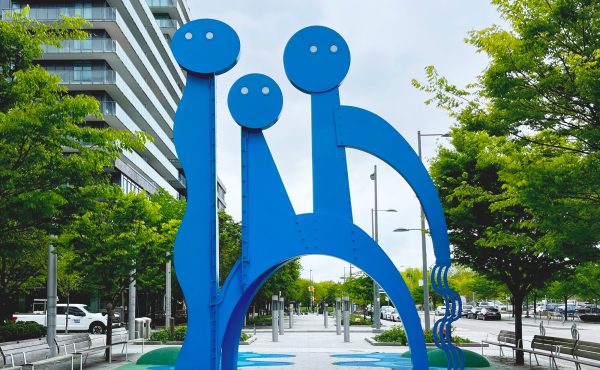
I thought I’d have a look at the impact of the cuts proposed by the City Manager as a result of the “Core Services Review” in terms of their impact on the walking environment. It’s not because I think walking is one of the significant areas hit by the proposed cuts, but rather the opposite — the really significant or visible impacts (child care, seniors and disabled care, zoos, etc) will get lots of attention, and maybe some of the cuts will be moderated or abandoned. But behind all that fuss, lots of little cuts will get no attention because there’s a limit to how much people can focus on, and they will slip through. The results will be small and gradual, but they will still have an impact.
– Cancelling the Neighbourhood Improvement Program. This program did one project in each ward every year, and often it was used to tranform an ugly, unpleasant space where people had to walk into an attractive space where people like to walk and spend time. A legacy of David Miller’s Clean and Beautiful City campaign, it was a way of gradually making the city better, so it’s not surprising it’s on the chopping block given the current administration’s approach.
– Reduction in litter clearing. Yes, sidewalks could get even more dirty and littered. In walkability studies, dirty and littered sidewalks often show up as something that creates what people perceive as an unwelcoming walking environment.
– Reduction in snow clearance (in parks and probably also streets and sidewalks). Uncleared snow has a big impact in discouraging people, especially seniors, from walking. On the plus side, the report suggests establishing a more coherent sidewalk snow shovelling program for seniors and people with disabilities (the City is supposed to do it now but the program is ineffective). But the problem isn’t just seniors’ own sidewalks, it’s the sidewalks of neighbours who don’t shovel and leave their sidewalk dangerous.
Which brings us to another proposal …
– Making Municipal Licensing and Standards enforcement less proactive and more reactive. It’s hard to imagine it could be any more reactive than it is now, but apparently it could. That would affect things like clearing sidewalk obstacles such as sandwich boards, derelict newspaper boxes, and getting people who don’t clear their sidewalk of snow to do so.
One solution is for citizens to become much more proactive in making complaints and getting bylaw officers to take action. The upcoming “24 Hour newspaper box guerilla art makeover” is a fine example of how citizens can take sidewalk maintenance into their own hands.
– Cuts to city planning. These are vaguely worded, but any reduction in the review the already understaffed city planning department does could mean less attention to making sure a new building enhances and improves the adjacent sidewalks and public spaces.
– Also, reconsidering the development-related public art program, which establishes public art as part of large new developments.
– the Parks department no longer planting flowers.
– cutting back on street tree planting. Street trees provide shade, wind-breaks, beauty and a buffer from cars for pedestrians.
– making Yonge-Dundas Square – a popular pedestrian destination – earn more money. Possibly that could mean measures such as renting it out as a private event space.
– Cutting back on support to Business Improvement Areas, which do work to make sidewalks attractive and appealing.
There’s no way of knowing how much any of these proposals would save, as the amount saved is not itemized in the report. So there’s no way to judge the benefits in relation to the costs.
Individually, the impact of each of these is small. And it’s quite possible some of them could be reasonable proposals for a city with a screwed-up budgetary process if they were thought through properly (e.g. all parks could have citizen committees that take care of flower planting and care, if the city provides the flowers and eases up on regulation). But done all in a rush, and all together, the overall impact will be a gradual degradation in the walking environment. It will get dirtier and trickier, and many programs that make it more attractive will be abandoned. People will still be able to walk, of course. They just won’t want to walk as much, unless they have to. And since walking is how people experience their city most directly, Toronto will feel a little bit more like a city in decline — which, given the amount of building going on and people moving in, it really shouldn’t.




3 comments
The planning staff reduction is reasonable and should go further. Doug Ford did such a bang-up job on Fordland-by-the-Lake that there is clearly no longer any need for a planning department.
Do we know yet whether annual events like Jane’s Walk will be affected in any way? That’s a great program for learning about walkability and I’m not certain if the city’s ever granted money for it.
And what about walking groups’ ability to use parks or get necessary permits to hold walking events? For example, the Toronto Field Naturalists and Lost Rivers groups lead many tours through Toronto Parks every year. Will they be forced to pay for permits for every hike?
And Heritage Toronto whose walking program is likely in trouble due to funding cuts, is required to get permits from the police to hold their tours because of crowds. Will those costs go up?
While overall their numbers are small, they do reveal how walkable and interesting Toronto is. Any monetary hit they take will reduce or eliminate their ability to do that.
Rather than planned cuts, the bigger threat is from the maverick, shoot-from-the-hip policy swings and public statements by a bully Mayor and his friends who have no understanding, use for or knowledge of how successful cities manage the pedestrian realm. These do far more damage than actual cuts to programs. (See: War on Scrambles)